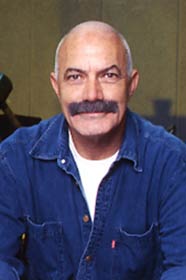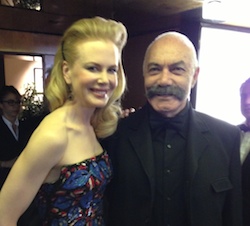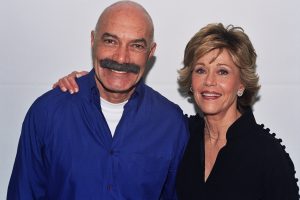



Melquiades doesn't want to be buried up here among all these fucking billboards. He is an insightful character worthy of respect, not of being shot down like a dog.
Three Burials of Melquiades Estarda, Tommy Lee Jones' impressive feature directorial debut, won two important awards at the Cannes Festival: Screenplay to Guillermo Arriaga and Actor to Tommy Lee Jones. The film is a potential Oscar contender in major categories, Picture, Screenplay, Director, Actor, and Cinematography.
The Idea's Origins
Tommy Lee Jones: Guillermo Arriaga and I are good friends and hunting buddies. I met him three or four years ago in California and he started joining is on our deer hunts on the WD ranch in Texas. Michael Fitzgerald, the producer, is also part of those hunting parties. The three of us were driving around in a truck one day and we said: We have a lot of talent in this truck. Let's make a movie.' Like a bunch of kids we set about it. But unlike a bunch of kids, we were able to bring it to reality.
The Movie's Subject
TLJ: All the thematic matters that I wanted to touch on were embodied in the true story of a young man who was killed by the US government, stupidly and partially by mistake. It was an outrageous incident and the events that followed were objectionable to the people whom live along the border between North Mexico and South Texas. That pretty much opened the floodgates for me.
Collaborating with Arriaga
Cuillermo wrote the screenplay in Spanish and had it translated by somebody he often works with. I hatched a plan to hire two other translators so I would have three English translations before I began to put together my own. Several drafts later, we had language that felt like it belonged in South Texas and sounded right, with the right rhythm and the right poetry, and we had the Northern Texas Spanish in the movie well polished. Guillermo has a very poetic ear for dialogue in Spanish and I tried to have the English dialogue match that poetic quality.
The Narrative Structure
The structure of the film is not chronological or linear. Guillermo indicated that he was not really a sequential writer. Strict mathematical sequence didn't interest him. I said that will be fine, because the point of view Im going to take on this story is that the past, the present and the future happen simultaneously.
My POV would be to present different perspectives in so-called sequential time and different perspectives in terms of the witnesses to events. As a result, the sequence of events is looked at from many different points of view, some are in the past, and some are in the present. People are always looking at each other. This is a recurrent theme. So we have lots of witnesses. Some of them are more thoughtful than others.
The Look of the Film, Shot by Oscar-Winer Chris Menges
My approach was based on loving the colors to death, and on being very bold. My sense of color comes from Mexico, Mondrian, Matisse, Jean-Luc Godard, Kurosawa. That's just the way I look at color.
Peter Perkins as a Character
My character, Pete Perkins, wants the same things an angel might want. Hed like to see peace on earth. There's something allegorical about the movie. Pete wants to see mankind do right. You can see who is right from the beginning. He's the foreman of a big ranch in West Texas. He's part of a bi-cultural society. He speaks both Spanish and English. Mexican culture has been integral to him all his life, from the food he eats to the words he uses to name his work tools.
When one of his ranch hands is killed, and he finds out that no further action is going to be taken, and that nobody is going to be brought to justice, he's outraged at the disrespect to his friend whom he respects for lots of good reasons and whom he does not disrespect simply because he's from Mexico and has no passport. Pete decided to remedy the situation by kidnapping the killer at gunpoint and making him dig the vaquero up for the second time, put him down to Mexico to his home town and bury him there.
Melquiades Estrada as the Last Western Gentleman
There's a lot of desire in Melquiades Estrada as most of it is expressed in terms of fantasy. He would love to have a simple agrarian life. It's a dream that he has. Circumstances have separated him from that dream, maybe even put it out of reach, but not killed it, as long as he can dream it.
He's a bit sentimental. Hed like to be buried at home and he makes his pal promise, if he dies on this side, to take him and bury him at home. I don't want to be buried here up here among all these fucking billboards,” he says. Melquiades is an insightful character worthy of respect, not of being shot down like a dog.
When he gives Pete his horse, he says, Sometimes you carry things around with you that you think are yours, but they really belong to someone else.' Melquiades is an angelic character. There's honesty there that I could only call glorious. He brings a blessing to people wherever he goes. There are people like him.
Mike Norton, the American Border Patrolman
The movie is about Mike's journey. His character (played by Saving Private Ryan's Barry Pepper) is representative of the common man. The stupid, brilliant, funny, sad things that people go through on the road to enlightenment and redemption are of interest here, and that's what the movie concerns itself with.
Producing, Directing and Starring in the Movie
Im a good actor for me as a director, because I do everything I tell myself to do. Im a good director for me an actor, because I can read my own mind. And Im a pretty good writer, because I know what these other two guys want to hear. And Im a good producer, because I know what they like to shoot, so I don't give them anything they don't need, but I am there with what they need.
The filming went beautifully. We were extremely well organized, so we were ready to go to very remote or dangerous places and get our work done. We made every day as










